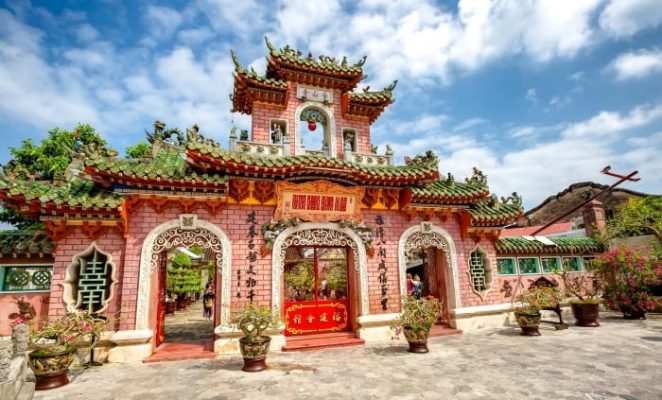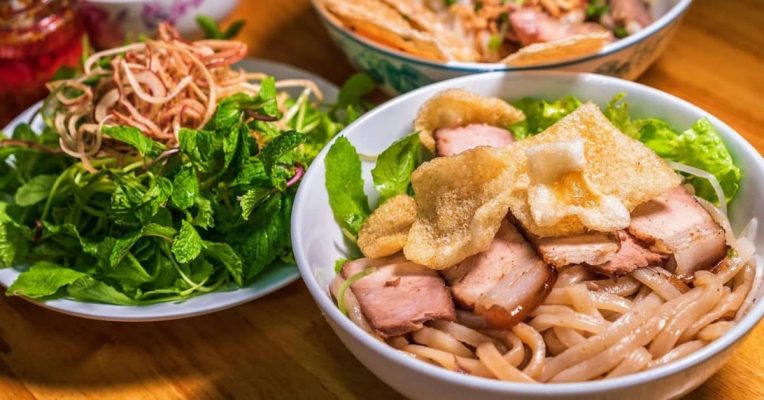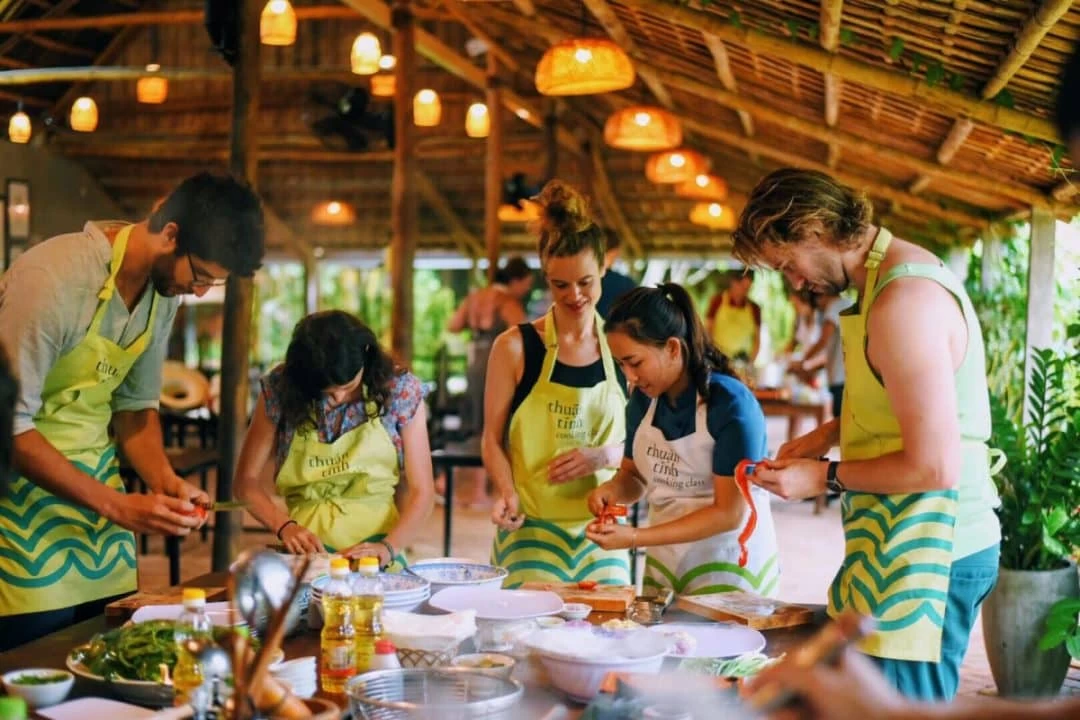
Hoi An Ancient Town.
Explore the picturesque Hoi An Ancient Town, a UNESCO World Heritage Site in Vietnam. Explore its fascinating history, distinctive architecture, and vibrant culture. Enjoy delectable local cuisine, vibrant night markets, and relaxing river cruises. Plan your trip with Ula Travel to Hoi An today!
I. Introduction to Hoi An Ancient Town
1. Overview of Hoi An Ancient Town

Hoi An Ancient Town with ancient beauty
Hoi An Ancient Town, located in central Vietnam, is a picturesque coastal city known for its well-preserved architecture and historical significance. Situated in Quang Nam Province, Hoi An lies on the banks of the Thu Bon River, approximately 30 kilometers south of Da Nang. Its strategic location along the central coast made it a crucial trading port from the 15th to the 19th centuries, attracting merchants from across Asia and Europe. Today, Hoi An stands as a living witness to a bygone age, offering tourists a look into its rich history through its small alleyways, classic wooden buildings, and numerous cultural influences.
2. UNESCO World Heritage Site

Hoi An Ancient Town- a UNESCO World Heritage Site in Vietnam
In 1999, Hoi An Ancient Town was officially recognized as a UNESCO World Heritage Site, a testament to its outstanding universal value. This recognition highlights Hoi An’s unique blend of cultures, which is evident in its architecture, urban layout, and the intangible cultural heritage passed down through generations. The town’s well-preserved buildings reflect a harmonious fusion of indigenous and foreign elements, with Chinese temples, Japanese merchant houses, French colonial buildings, and traditional Vietnamese structures coexisting side by side.
The UNESCO designation not only underscores Hoi An’s historical and cultural importance but also helps in its preservation and promotion as a significant tourist destination. The town’s commitment to maintaining its architectural integrity and cultural authenticity makes it a living museum, where visitors can experience the charm and elegance of a historical trading port.
Click here: Hoi An Tours
II. History of Hoi An Ancient Town

Hoi An 1930 – 1950
Hoi An Ancient Town, located on the central coast of Vietnam, has a rich and storied history that dates back to the 15th century. Hoi An served as one of Southeast Asia’s most important trading ports from the 15th to the 19th centuries. Merchants from Japan, China, India, and even Europe flocked to Hoi An, establishing it as a bustling international commercial hub.
During its peak, Hoi An was renowned for its strategic location on the Thu Bon River, which facilitated trade and cultural exchanges. The town’s prosperity attracted various foreign traders who settled in Hoi An, contributing to its diverse cultural fabric. The architecture and layout reflect the influences of these diverse cultures, making it a unique blend of local and international elements.
However, in the late 19th century, Hoi An’s significance as a trading port declined due to the silting of the Thu Bon River and the rise of other ports, such as Da Nang. Despite this decline, Hoi An managed to preserve its historical architecture and charm. Today, it stands as a living museum, showcasing well-preserved buildings and streetscapes that offer a glimpse into its vibrant past.
III. Top Attractions in Hoi An Ancient Town
1. Japanese Covered Bridge

Japanese Covered Bridge
The Japanese Covered Bridge is one of the most iconic landmarks in Hoi An. Built in the early 17th century by the Japanese community, the bridge was intended to create a link with the Chinese quarters across the river. This architectural marvel reflects a unique blend of Japanese, Chinese, and Vietnamese design elements.
Start your journey with: Explore Hoi An in 1 Day
2. Tan Ky Old House

Tan Ky Old House
Tan Ky Old House, built over 200 years ago, is a prime example of a traditional merchant’s residence in Hoi An. The house has been remarkably preserved through seven generations, maintaining its original architecture and interior design.
Architecture: The structure is a seamless blend of Japanese, Chinese, and Vietnamese influences. The wooden beams and intricate carvings are reminiscent of Japanese design, while the Yin-Yang tiled roof reflects Chinese architecture. The house is divided into various sections, including a living area, a courtyard, and storage rooms, each serving a distinct purpose.
Historical Value: Tan Ky Old House has witnessed the rise and fall of Hoi An as a trading port. It offers visitors a glimpse into the lifestyle of affluent merchants during the town’s heyday. The house is filled with antique furniture, family heirlooms, and historical artifacts that tell the story of Hoi An’s prosperous past.
Do not miss: Best things to do in Hoi An
3. Phuc Kien Assembly Hall

Phuc Kien Assembly Hall
Originally built in 1697, the Phuc Kien Assembly Hall was constructed by Chinese merchants from Fujian Province. It served as a communal gathering place for social and religious activities.
Architecture: The assembly hall is renowned for its grand and elaborate architecture. The main hall features intricate wood carvings, colorful murals, and statues of deities, including Thien Hau, the goddess of the sea, who protects sailors and fishermen.
Festivals and Events: Phuc Kien Assembly Hall is the center of numerous traditional festivals and events. The most notable is the celebration of Thien Hau’s birthday, which attracts both locals and tourists. During the festival, the hall is adorned with lanterns, and rituals are performed to honor the goddess. These events offer a vibrant glimpse into the rich cultural heritage of the Chinese community in Hoi An.
Are you looking for: Central Vietnam Wonders Tour
4. Hoi An Market

Hoi An Market
Hoi An Market, located in the heart of the ancient town, is a bustling hub of activity and a must-visit for any traveler. It offers a sensory overload with its vibrant colors, sounds, and smells.
Shopping: The market is an excellent place to shop for local handicrafts, souvenirs, and textiles. You can find everything from hand-woven fabrics, traditional lanterns, and ceramics to exotic spices and herbs.
Local Cuisine: Hoi An Market is also a culinary paradise. The food stalls offer a wide variety of local delicacies, including the famous Cao Lau, a noodle dish unique to Hoi An, and Banh Mi, a Vietnamese baguette sandwich. Fresh seafood, tropical fruits, and traditional sweets are also abundantly available. For an immersive experience, visitors can join a cooking class that starts with a market tour to select fresh ingredients, followed by a hands-on cooking session.
Let’s discover 7 of the best things to do in Hoi An!
IV. Signature Cuisine in Hoi An Ancient Town
1. Traditional Dishes

Cao Lau – Famous specialty of Hoi An
Hoi An Ancietn Town is a culinary paradise, offering a variety of traditional dishes that reflect the rich cultural heritage of the town. Some must-try traditional dishes include:
- Cao lau: This is perhaps the most famous dish in Hoi An. Cao lau is a noodle dish that features thick rice noodles, pork slices, fresh herbs, and crunchy croutons, all bathed in a light yet flavorful broth. The noodles are unique to Hoi An as they are said to be made using water from an ancient Cham well, adding to their distinctive texture and taste.
- Quang Noodle: Another iconic dish from the region, Quang Noodle is a flavorful noodle soup with a rich broth made from pork, shrimp, and chicken. The dish is typically served with a variety of fresh herbs, crushed peanuts, and a slice of lime, making it a vibrant and aromatic experience.
- White Rose Dumplings: Also known as White Rose Dumplings, these delicate dumplings are filled with minced shrimp or pork and wrapped in translucent rice paper. They are steamed, often garnished with crispy shallots, and served with a tangy dipping sauce.
Learn more about: Hoi An Cuisine
2. Cooking Classes

Cooking Classes in Hoi An
For those interested in bringing a piece of Hoi An back home, participating in a Hoi An cooking class is a fantastic way to learn more about Vietnamese cuisine and culinary techniques. Many cooking schools in Hoi An offer comprehensive classes that include:
- Market tours: Classes often start with a visit to a local market where participants can learn about and select fresh ingredients.
- Hands-on experience: Under the guidance of skilled chefs, participants will prepare several traditional dishes from scratch, gaining practical knowledge of Vietnamese cooking methods.
- Recipe booklets: Most classes provide take-home recipes, so participants can recreate the dishes in their own kitchens.
Some popular cooking schools in Hoi An include Red Bridge Cooking School, Green Bamboo Cooking School, and Tra Que Water Wheel. These classes not only teach cooking skills but also offer a deeper understanding of the local culture and the significance of each dish.
You might also like: Da Nang to Hoi An in 4 Days
V. Activities and Experiences When Coming to Hoi An Ancient Town
1. Cycling Around the Ancient Town

Cycling Explore the Ancient Town
Cycling is one of the best ways to explore the charming streets of Hoi An Ancient Town. The town is compact and has relatively flat terrain, making it perfect for a leisurely bike ride. Here’s a suggested route and what you can expect to experience:
Suggested Route:
- Start at the Japanese Covered Bridge: Begin your journey at this iconic symbol of Hoi An. Take time to appreciate the unique architecture and the historical significance of this 18th-century structure.
- Explore Tran Phu Street: Cycle along Tran Phu Street, where you’ll find a mix of ancient houses, shops selling traditional crafts, and local eateries. This street is bustling with activity and offers a glimpse into the daily lives of the locals.
- Visit Tan Ky House: Stop by this well-preserved 200-year-old merchant house. Its architecture reflects the influence of Japanese, Chinese, and Vietnamese styles.
- Ride along Nguyen Thai Hoc Street: This street is known for its art galleries and craft shops. You can stop and admire the local artwork or purchase unique souvenirs.
- End at the Central Market: Conclude your ride at the Central Market, where you can sample local delicacies, shop for fresh produce, or simply observe the vibrant market life.
Experience: Cycling through ancient streets allows you to soak in the town’s historic ambiance at your own pace. The narrow lanes, lined with mustard-yellow buildings and lanterns, create a picturesque setting. As you pedal, you can stop at various points of interest, interact with friendly locals, and enjoy the delightful fusion of historical and cultural elements.
Learn more about: Discover My Son Sanctuary from Hoi An and Street Food Tour
2. Boat Tour

Bamboo Basket Boat Tour
A boat tour on the Thu Bon River offers a different perspective on Hoi An and its surroundings. These tours are usually conducted in traditional wooden boats, adding to the authentic experience.
Tour Highlights:
- Departure from the Ancient Town: Most boat tours start from the docks near the ancient town. As you embark, you’ll have a beautiful view of Hoi An’s waterfront, lined with ancient buildings and bustling activity.
- Visit to Kim Bong Carpentry Village: The first stop is often Kim Bong Carpentry Village, located on Cam Kim Island. Here, you can see traditional woodworking techniques that have been passed down through generations.
- Stop at Thanh Ha Pottery Village: Another interesting stop is Thanh Ha Pottery Village, where you can watch artisans create intricate pottery pieces and even try your hand at making your own.
- Cruising Through Coconut Palms: Some tours include a detour through the water coconut palm forest in Cam Thanh Village, offering a serene and scenic escape from the main river.
Experience: A boat tour on the Thu Bon River is a tranquil and scenic way to experience Hoi An. The gentle flow of the river, combined with the lush greenery along the banks, provides a relaxing backdrop. The stops at traditional villages add cultural depth to the journey, allowing you to witness and participate in local crafts and traditions.
More details: Discover Central Vietnam Tour in 6 Days
3. Participating in the Hoi An Lantern Festival

Hoi An Lantern Festival
The Hoi An Lantern Festival is a magical event that transforms the ancient town into a glowing wonderland. This festival is held on the 14th day of every lunar month, when the moon is at its brightest.
Timing:
- The Lantern Festival takes place in the evening, typically starting around 6 p.m. and lasting until late at night.
- The best time to experience the festival is around 8 p.m. to 9 p.m., when the town is fully illuminated by the lanterns.
Atmosphere: During the Lantern Festival, Hoi An’s electricity is turned off to allow the lanterns to shine brightly. The streets are adorned with colorful lanterns of various shapes and sizes, creating a mesmerizing and romantic atmosphere. Here’s what you can expect:

Floating Lanterns on the River
- Floating Lanterns on the River: One of the highlights is releasing floating lanterns onto the Thu Bon River. Visitors can purchase these lanterns from vendors along the river and make a wish as they set them afloat.
- Traditional Performances: Throughout the town, you’ll find traditional music and dance performances, adding to the festive ambiance.
- Street Food and Local Delicacies: The festival is also an excellent opportunity to sample Hoi An’s street food. Stalls offering a variety of local treats line the streets, making it a culinary adventure.
- Cultural Activities: Participate in traditional games and activities, such as bai choi (a form of bingo) and calligraphy demonstrations.
Experience: The Hoi An Lantern Festival is a unique cultural experience that captivates visitors with its beauty and charm. The sight of thousands of lanterns illuminating the ancient streets and floating on the river is unforgettable. The festival not only celebrates Hoi An’s heritage but also brings people together in a joyous and harmonious celebration.
VI. Tips for Visiting Hoi An Ancient Town
1. Best Time to Visit
- Ideal Seasons: The best time to visit Hoi An is from February to April and from August to October, when the weather is mild and pleasant.
- Avoiding the Rainy Season: Try to avoid the rainy season from October to January, as heavy rains and potential flooding can impact travel plans.
2. Accommodation
- Variety of Options: Hoi An offers a range of accommodations, from budget hostels to luxury resorts. Consider staying in a traditional guesthouse for an authentic experience.
- Popular Areas: Stay near the old town for easy access to attractions, or choose a beachfront resort for a relaxing retreat.
Click here: Best Accommodations in Hoi An
3. Money and budgeting
- Currency: The local currency is the Vietnamese dong (VND). Carry some cash for small purchases, as not all vendors accept credit cards.
- Bargaining: Bargaining is common in markets and small shops. Don’t hesitate to negotiate prices, but always do so respectfully.
In summary, Hoi An Ancient Town captivates with its blend of historical depth, cultural richness, culinary delights, and natural beauty. Its unique charm and diverse attractions make it an essential destination for any traveler seeking an unforgettable experience in Vietnam. Plan your visit to Hoi An and discover why it remains a beloved gem among the world’s historic towns.
See more: Hoi An Travel Tips




























